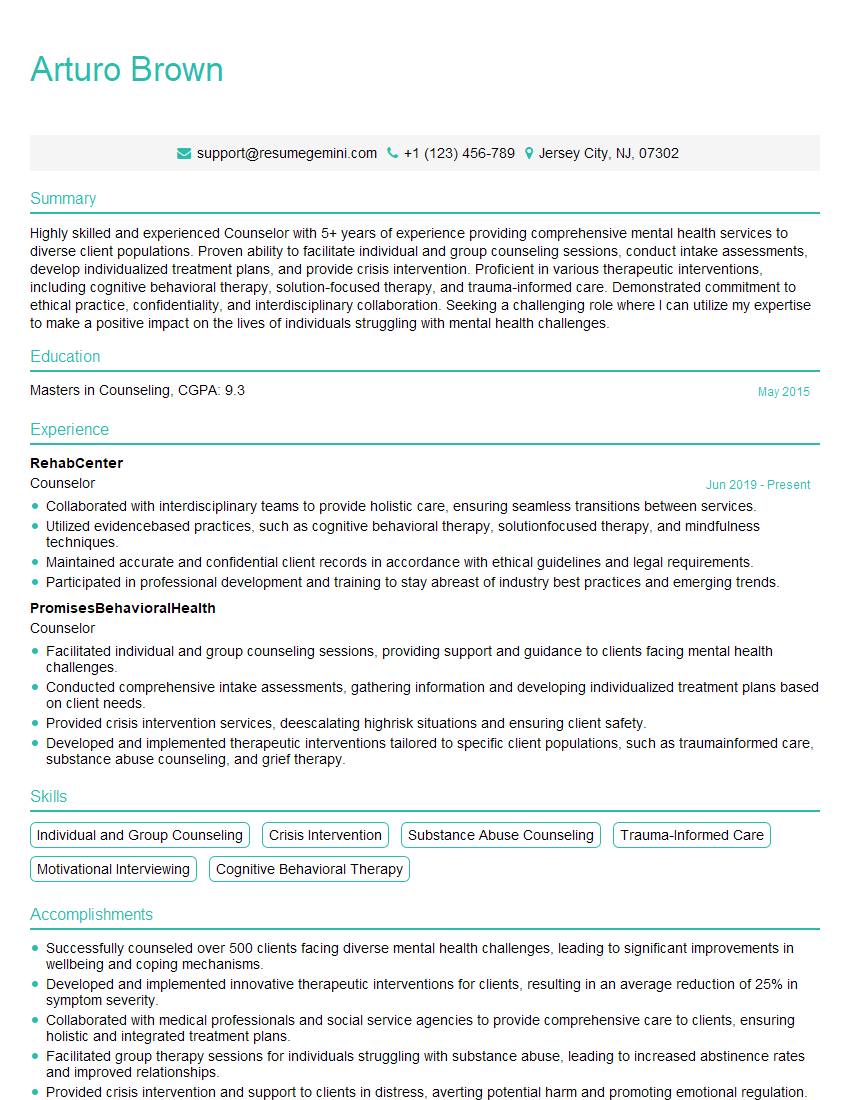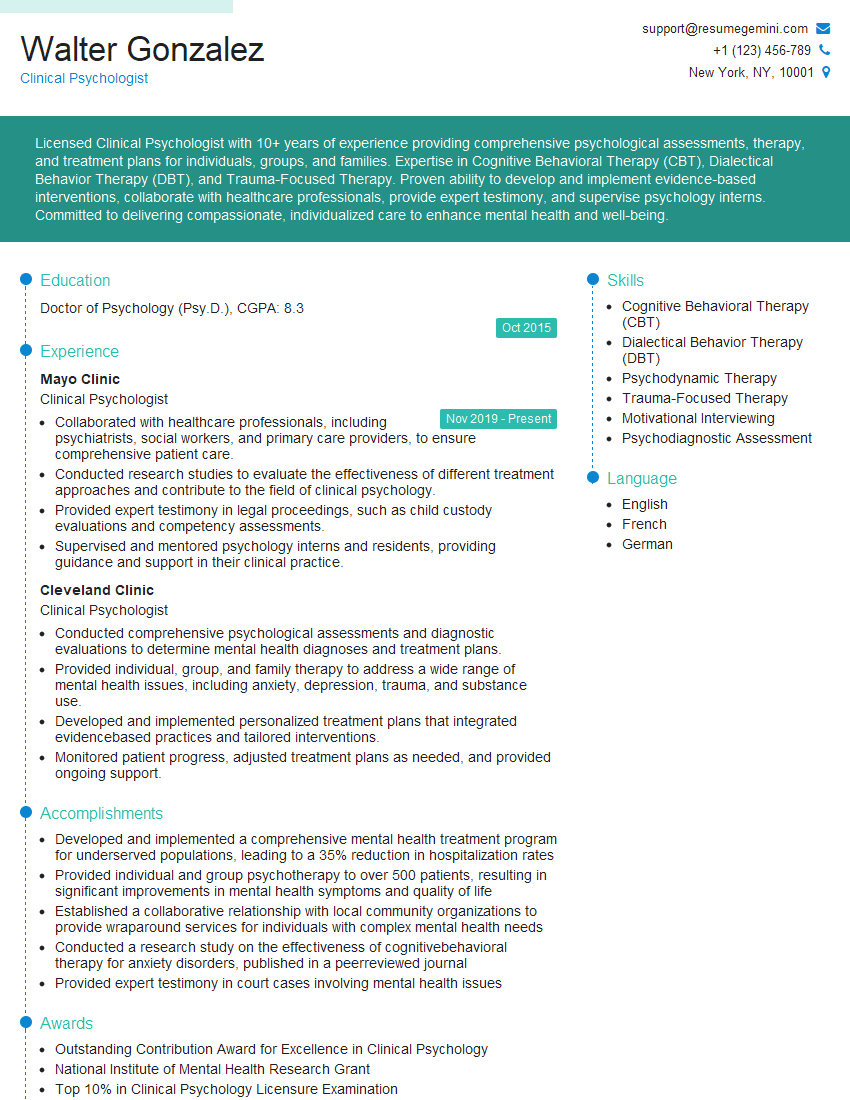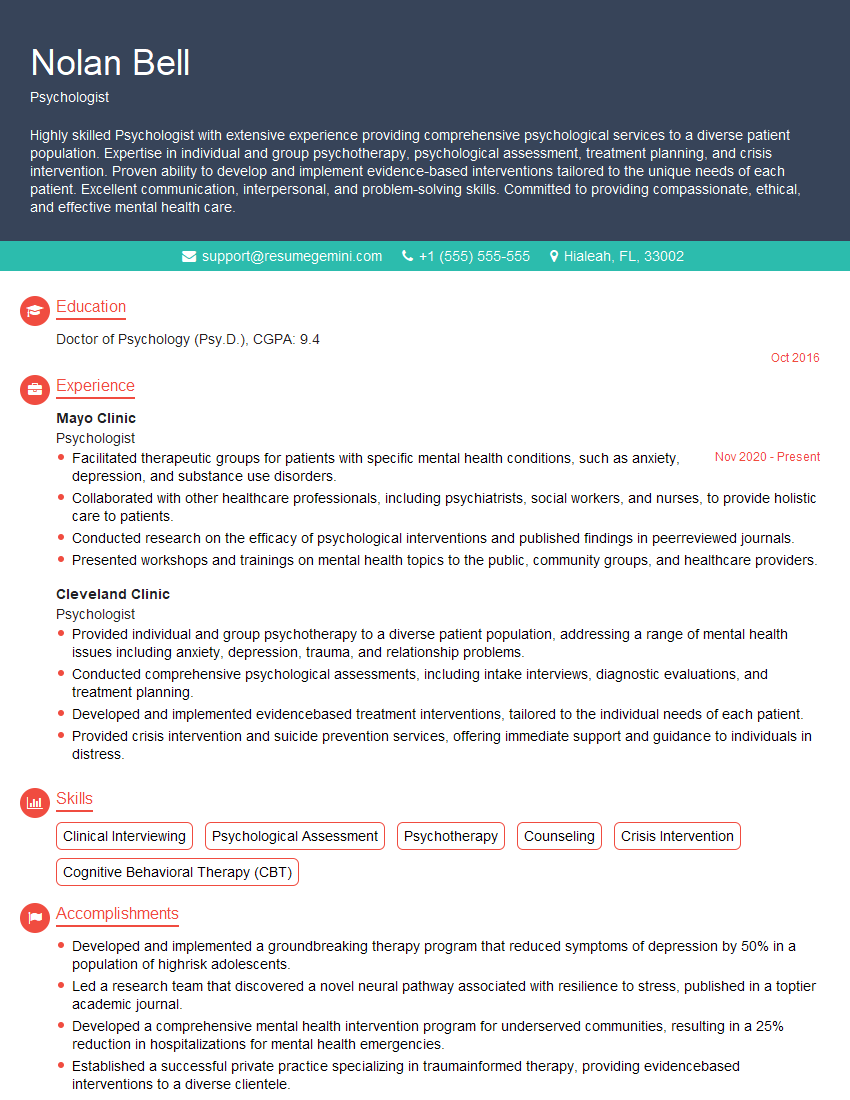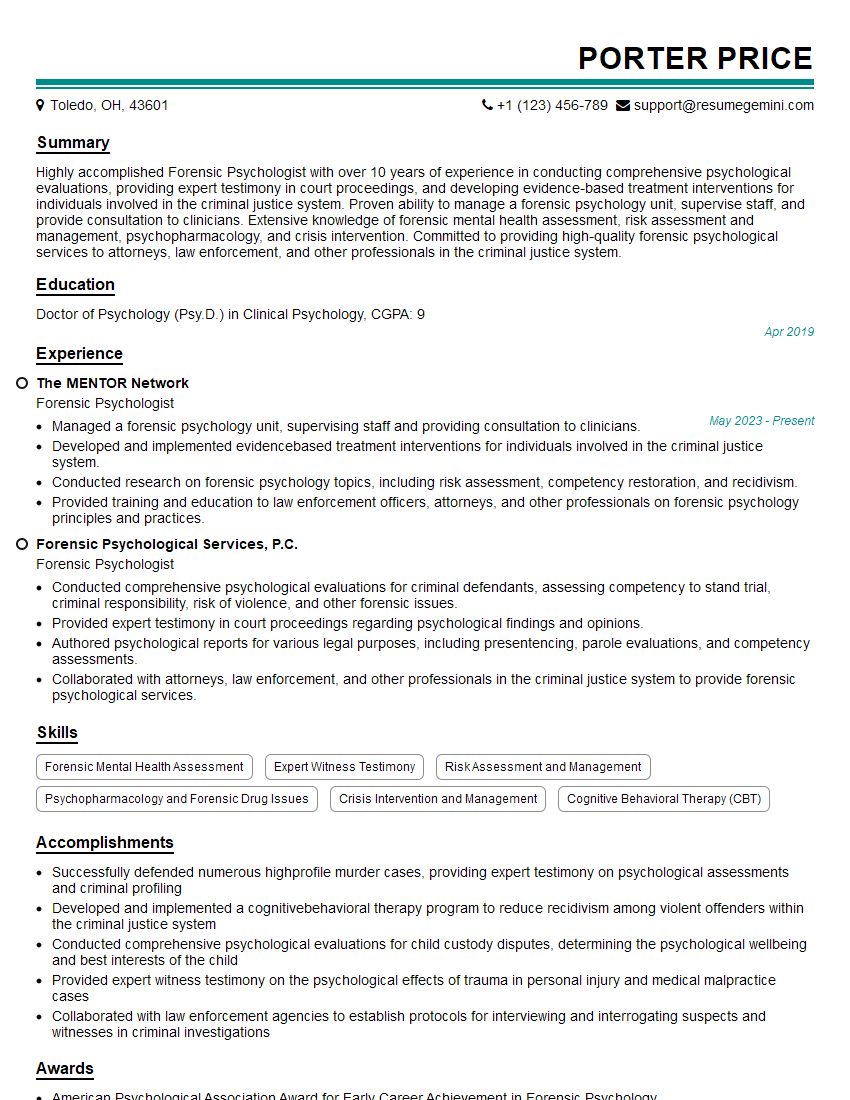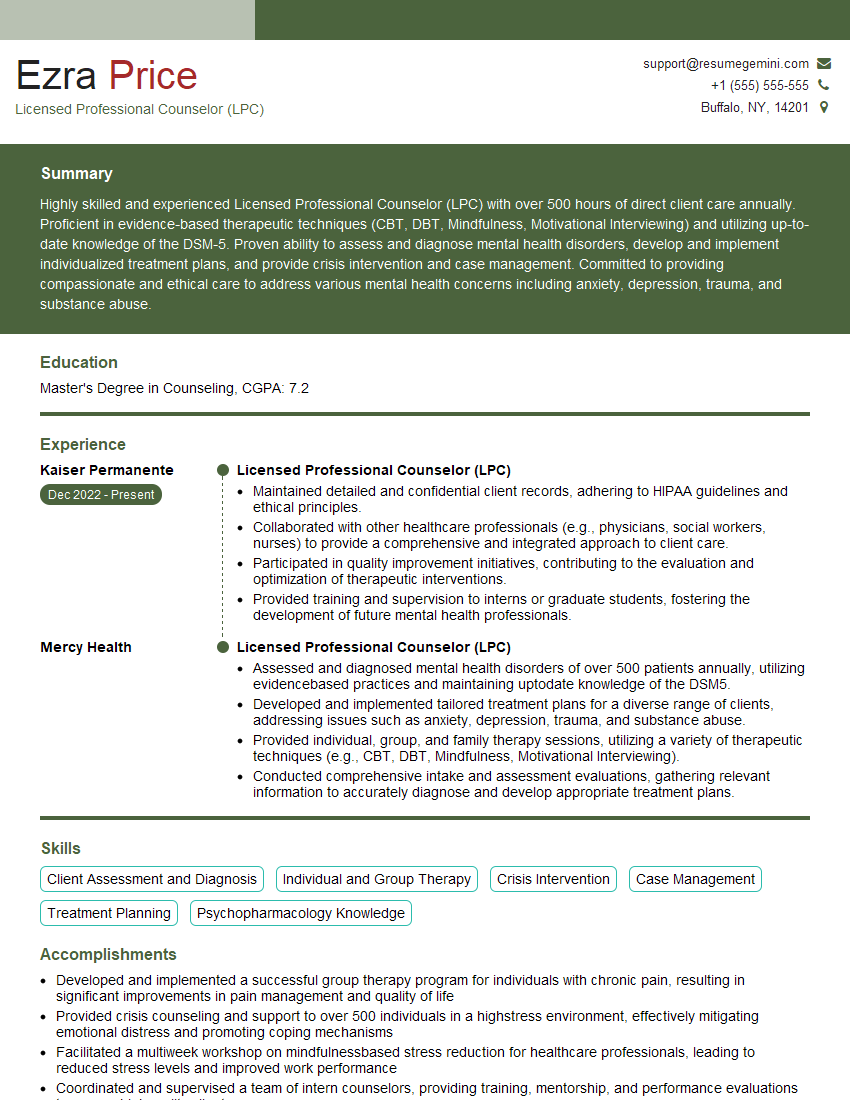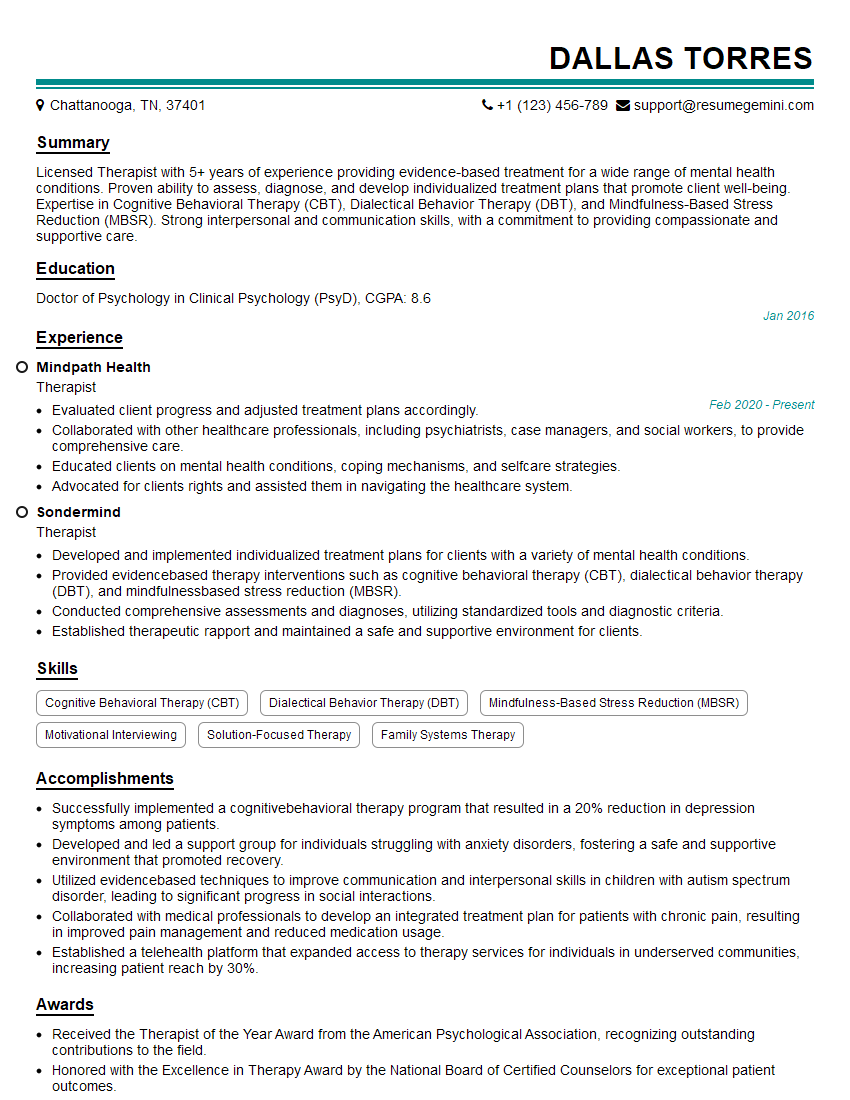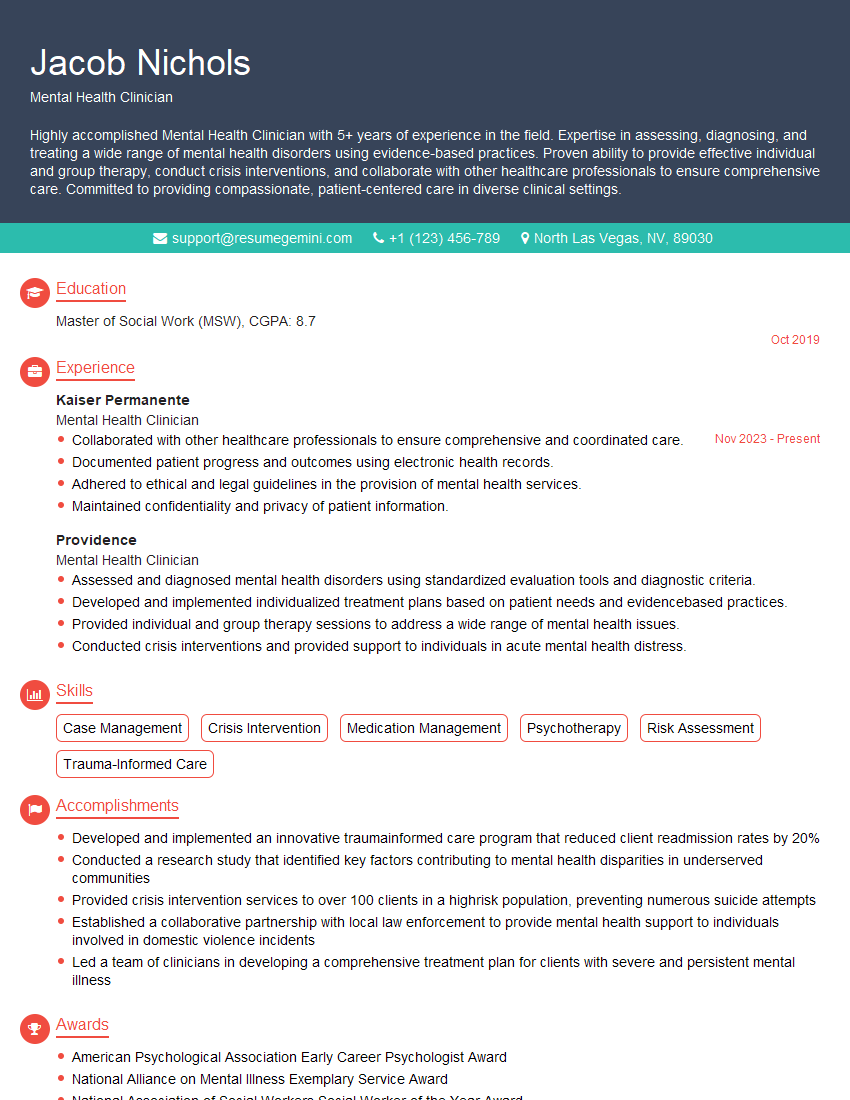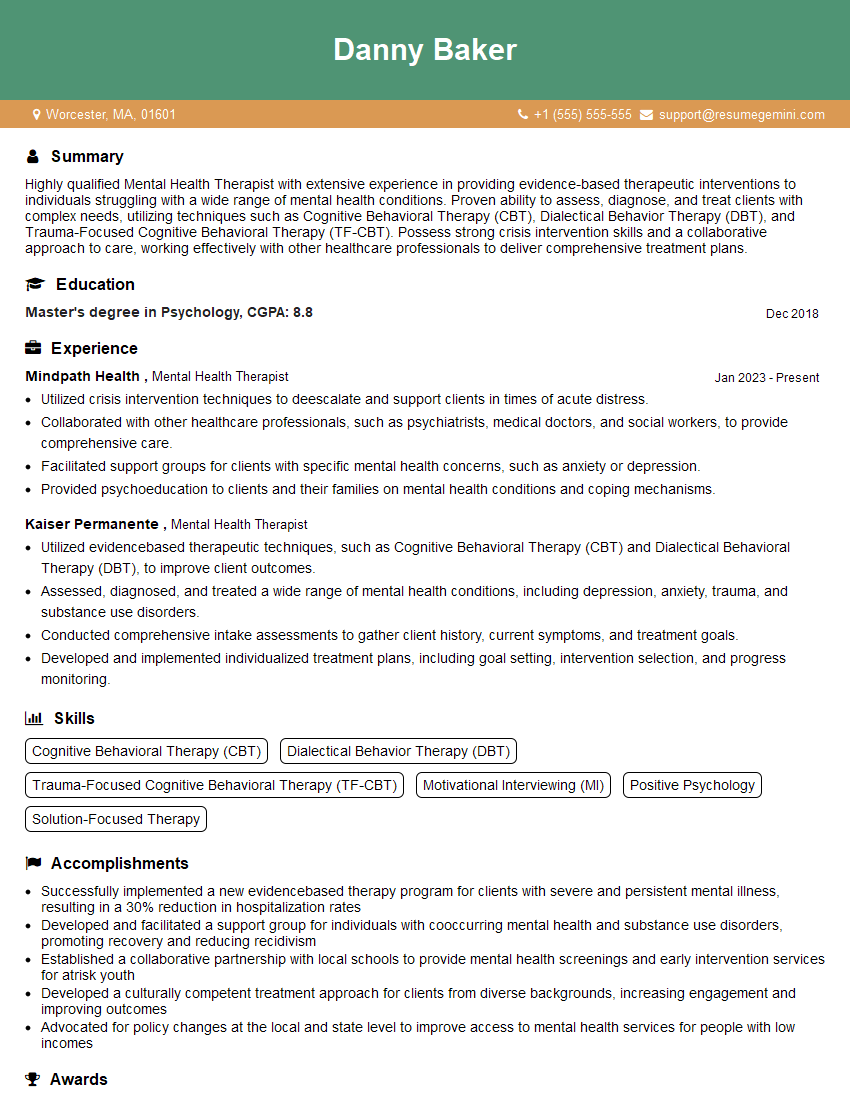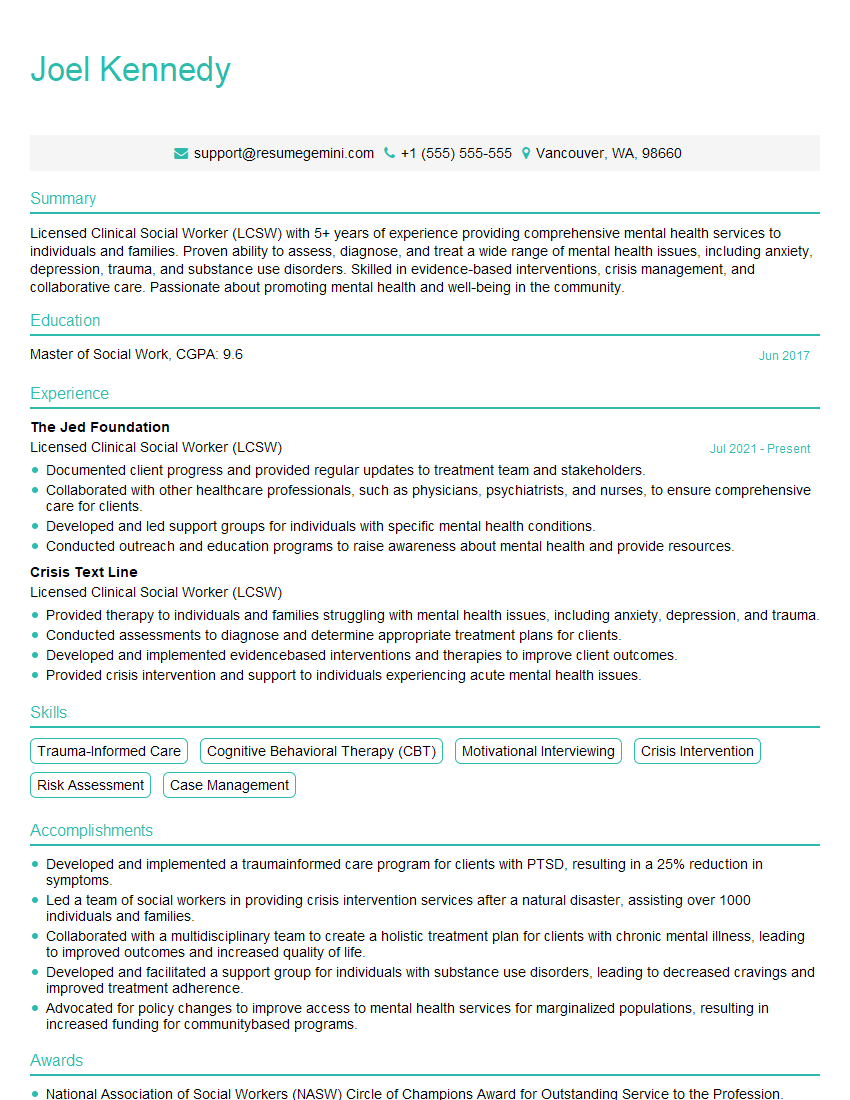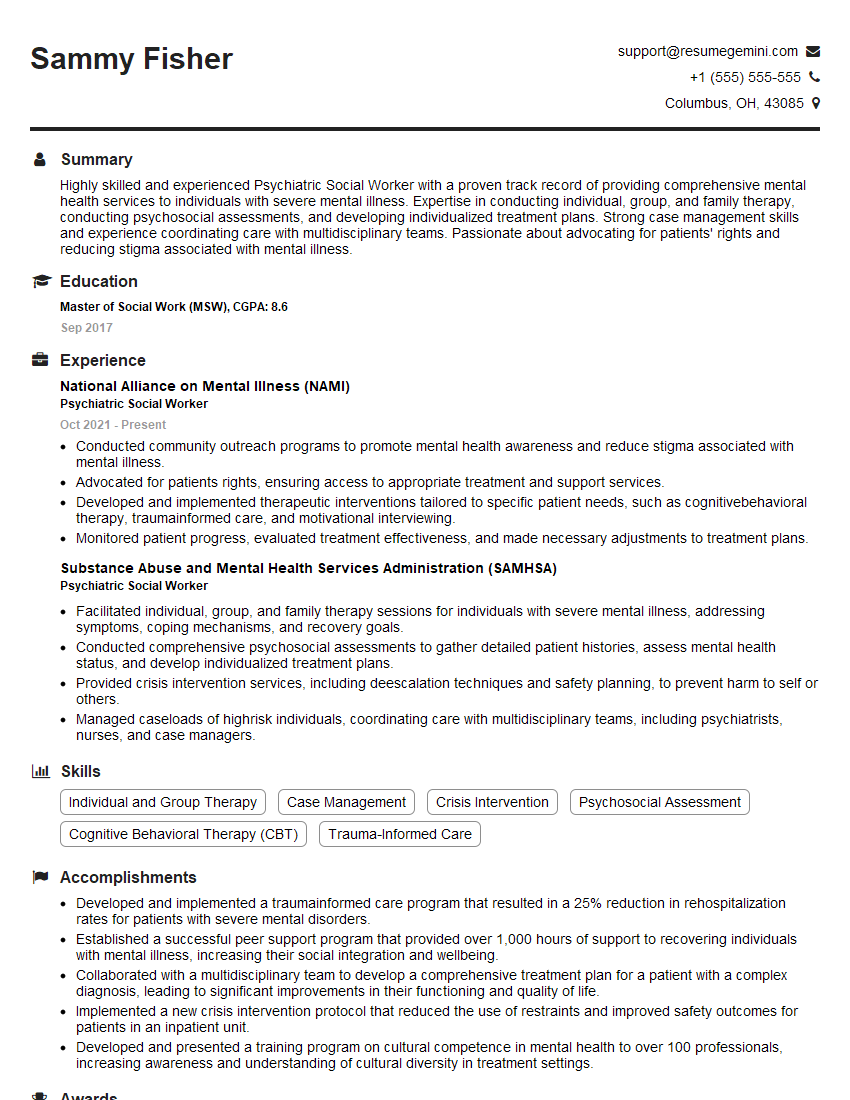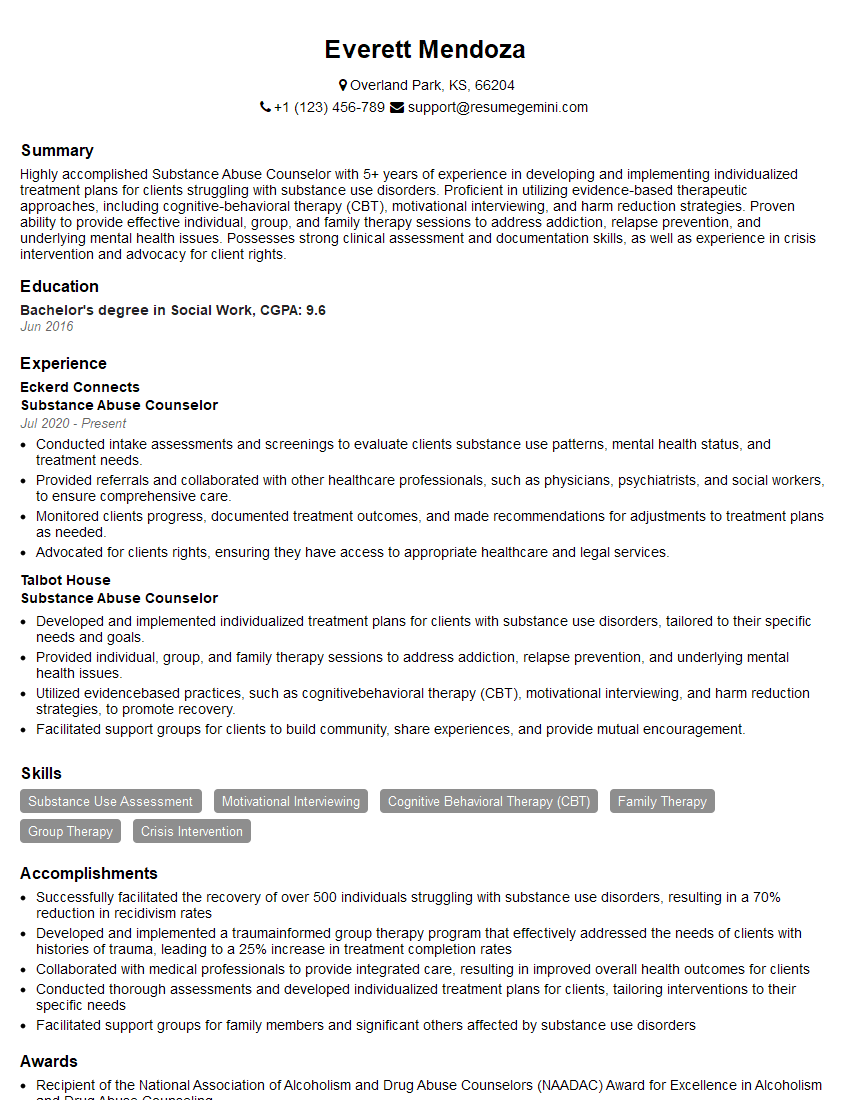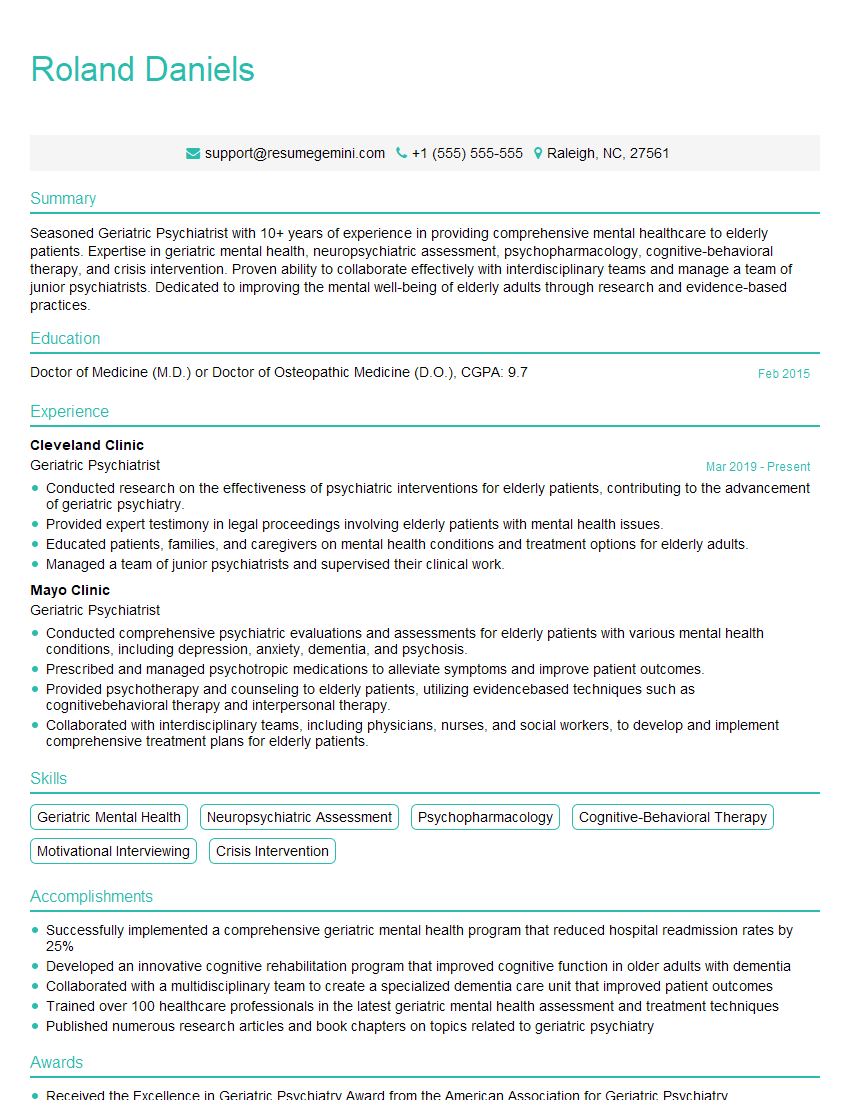Every successful interview starts with knowing what to expect. In this blog, we’ll take you through the top Behavioral Health Assessment interview questions, breaking them down with expert tips to help you deliver impactful answers. Step into your next interview fully prepared and ready to succeed.
Questions Asked in Behavioral Health Assessment Interview
Q 1. Describe your experience conducting comprehensive behavioral health assessments.
A comprehensive behavioral health assessment is a multifaceted process aimed at understanding an individual’s mental, emotional, and behavioral functioning. It involves gathering information from various sources to create a holistic picture of their current state and contributing factors. My approach integrates clinical interviewing, standardized assessments, and collateral information whenever possible.
This process typically begins with a detailed clinical interview exploring the presenting problem, history of mental health concerns, developmental history, family dynamics, social supports, and current stressors. I then use standardized tools to quantify symptoms and gather objective data, supplementing the interview with observations of the individual’s behavior, mood, and affect. Finally, I may consult with family members or other relevant professionals – only with the client’s explicit consent – to gain a more comprehensive understanding.
For example, with a client presenting with anxiety, the assessment would include exploring the onset, frequency, intensity, and impact of their anxiety, using standardized measures like the Generalized Anxiety Disorder 7-item scale (GAD-7), while also exploring potential triggers, coping mechanisms, and the impact on their daily functioning. I would also investigate for any comorbid conditions, such as depression or substance use.
Q 2. What assessment tools are you proficient in using (e.g., DSM-5, mental status exams)?
I’m proficient in using a range of assessment tools. This includes the structured clinical interview for DSM-5 disorders (SCID-5), which helps diagnose mental disorders according to the DSM-5 criteria. I’m also skilled in administering and interpreting mental status exams (MSEs), which provide a snapshot of a person’s cognitive functioning at a given point in time. These are invaluable tools. Other assessments I frequently use include:
- Beck Depression Inventory (BDI-II): Measures the severity of depression.
- State-Trait Anxiety Inventory (STAI): Differentiates between state and trait anxiety.
- Millon Clinical Multiaxial Inventory (MCMI-IV): Assesses personality disorders.
- Trauma Symptom Checklist (TSC): Screens for symptoms of trauma and PTSD.
The choice of assessment tools depends on the client’s presenting problem and the specific information needed to develop a comprehensive treatment plan.
Q 3. How do you differentiate between various mental health disorders during assessment?
Differentiating between mental health disorders requires a careful and systematic approach. It’s not simply a matter of ticking boxes; it involves integrating multiple sources of information to understand the unique constellation of symptoms, their onset, course, and impact on the individual’s life. The DSM-5 provides diagnostic criteria, but clinical judgment is essential to making an accurate diagnosis.
For example, differentiating between anxiety and depression often relies on the predominant symptom clusters. Anxiety involves excessive worry, fear, and physical symptoms like rapid heartbeat, while depression is characterized by persistent sadness, loss of interest, changes in sleep and appetite, and feelings of hopelessness. However, the two can co-occur, highlighting the importance of a thorough assessment. Similarly, distinguishing between bipolar disorder and major depressive disorder requires assessing for the presence of manic or hypomanic episodes, which are characterized by elevated mood, increased energy, and impulsive behavior. A detailed history, incorporating the client’s own narrative and collateral information, is crucial in this process. I regularly consult the DSM-5 and other relevant research to inform my diagnostic impressions.
Q 4. Explain your approach to assessing risk factors for suicide or self-harm.
Assessing suicide and self-harm risk is a critical aspect of behavioral health assessment, requiring sensitivity and expertise. My approach involves a multi-faceted assessment, encompassing the following:
- Direct Inquiry: I explicitly ask about suicidal or self-harming thoughts, plans, and intent. This is done in a non-judgmental, empathetic manner.
- Risk Factors: I assess for known risk factors, including previous suicide attempts, hopelessness, impulsivity, substance abuse, severe mental illness, social isolation, access to lethal means, and significant life stressors.
- Protective Factors: I also identify protective factors such as strong social support, coping skills, religious beliefs, and treatment engagement, which can mitigate the risk.
- Suicide Risk Assessment Tools: I may utilize validated scales, such as the Suicide Risk Assessment Scale (SAS), depending on the client’s presentation.
Based on the assessment, a risk level is determined, and appropriate interventions are implemented, which could range from providing support and safety planning to hospitalization in cases of imminent danger. It is crucial to remember that a person’s suicide risk can change rapidly, requiring ongoing monitoring and adjustments to the treatment plan.
Q 5. How do you incorporate cultural considerations into your assessment process?
Cultural considerations are paramount in behavioral health assessment. Ignoring cultural factors can lead to misdiagnosis and ineffective treatment. My approach involves:
- Cultural Humility: Recognizing the limits of my own cultural understanding and engaging in ongoing learning.
- Cultural Sensitivity: Demonstrating respect for clients’ beliefs, values, and practices.
- Culturally Adapted Assessment Tools: Using assessment tools that are validated and appropriate for the client’s cultural background. When available, I will utilize culturally adapted versions of standardized assessments or select measures that avoid cultural bias.
- Understanding Cultural Norms: Taking into account how cultural norms may influence the expression of symptoms or help-seeking behavior. For example, some cultures may stigmatize mental illness, leading to underreporting of symptoms.
- Language Access: Ensuring appropriate language interpretation or translation services, when needed.
By incorporating these cultural considerations, I strive to create a safe and respectful environment where clients feel comfortable sharing their experiences and receiving culturally competent care.
Q 6. Describe a situation where you had to adapt your assessment strategy based on a client’s presentation.
I once encountered a client who presented with seemingly nonspecific somatic complaints, such as chronic fatigue and headaches. Initially, my assessment focused on standard psychological measures for depression and anxiety. However, the results were not entirely consistent with her presentation. Through careful and attentive listening during the interview, I noticed she was hesitant to discuss her personal life and would shift topics when certain words or themes were mentioned. This prompted me to adjust my approach and explore the possibility of trauma. This required building trust through more open-ended questions and utilizing trauma-informed assessment tools. After establishing a therapeutic rapport, she finally disclosed a history of childhood abuse, which provided the crucial missing piece to understand her symptoms. The assessment then shifted to a trauma-focused approach. This highlighted the importance of flexibility and adaptability in tailoring assessment strategies to meet the individual needs and characteristics of each client.
Q 7. How do you maintain client confidentiality during the assessment process?
Maintaining client confidentiality is of utmost importance and is at the core of my professional ethics. I adhere strictly to HIPAA regulations and all relevant professional guidelines. This includes:
- Informed Consent: Obtaining informed consent from clients before initiating any assessment procedures, clearly outlining how their information will be used and protected.
- Secure Storage of Records: Maintaining client records in a secure and confidential manner, both electronically and physically.
- Limited Access: Restricting access to client information to authorized personnel only, using password-protected electronic systems and secure file storage.
- Confidentiality in Reporting: Only disclosing information to third parties with the client’s explicit permission or when legally mandated.
- Data Security: Regularly updating security protocols and software to prevent data breaches. I am highly attuned to technology issues that might compromise confidentiality.
My commitment to confidentiality builds trust and fosters a safe therapeutic relationship, enabling clients to openly discuss sensitive issues and participate fully in the assessment process.
Q 8. How do you handle situations where clients are resistant to assessment?
Client resistance to assessment is common and often stems from mistrust, fear of judgment, or a lack of understanding of the process’s purpose. My approach prioritizes building rapport and establishing a therapeutic alliance. I begin by actively listening to their concerns and validating their feelings. Transparency is key; I explain the assessment’s goals, emphasizing how it will help them achieve their treatment objectives.
If resistance persists, I might offer a collaborative approach, allowing them to choose which assessments to complete, or adjust the assessment format to better suit their preferences (e.g., using less formal interviews). Sometimes, starting with less intrusive assessments and gradually progressing to more comprehensive ones can be helpful. For example, I might begin with a brief conversation to establish rapport before administering a standardized measure. I always ensure they have the autonomy to decline any assessment at any time.
For example, I once had a client who was extremely anxious about a personality inventory. Instead of forcing the issue, we spent a session discussing their anxiety, and I explained each section of the assessment in detail, addressing their concerns individually. This approach led to their willing participation and ultimately provided valuable insights for treatment planning.
Q 9. What are the limitations of standardized assessments, and how do you mitigate these?
Standardized assessments, while valuable, have limitations. One key limitation is their inherent cultural bias; norms are often based on specific populations, potentially leading to inaccurate interpretations for individuals from diverse backgrounds. Another limitation is the reliance on self-report, which can be influenced by factors like social desirability bias (the tendency to present oneself in a positive light) or response sets (consistent patterns of responding irrespective of question content). Furthermore, standardized tests often lack the nuance to capture the complexity of individual experiences and contexts.
To mitigate these limitations, I employ a multi-method assessment approach. This involves using multiple assessment tools – including standardized measures, clinical interviews, and collateral information from family or other professionals – to obtain a more comprehensive understanding. When using standardized measures, I carefully consider the instrument’s psychometric properties (reliability and validity) and its suitability for the client’s cultural background. I also interpret results cautiously, considering contextual factors and supplementing them with qualitative data from interviews. Finally, I strive to create a comfortable and non-judgmental assessment environment to encourage honest self-reporting.
Q 10. Explain your understanding of the biopsychosocial model and its role in assessment.
The biopsychosocial model is a holistic framework that considers the interplay of biological, psychological, and social factors in understanding mental health. In assessment, this model guides me to explore a client’s condition from multiple perspectives. Biological factors include genetic predispositions, neurological conditions, and the effects of substance use. Psychological factors encompass thoughts, feelings, behaviors, and coping mechanisms. Social factors examine the individual’s environment, relationships, and sociocultural context. For example, a client experiencing depression might have a family history of mood disorders (biological), negative thought patterns (psychological), and recent job loss (social).
The model’s role in assessment involves systematically gathering information across these three domains. Clinical interviews are essential for exploring psychological and social factors, while review of medical records or other biological data may be necessary. Understanding how these factors interact is critical for developing an accurate diagnosis and an effective treatment plan. For instance, a treatment plan for the depressed individual mentioned above might involve medication (biological), cognitive behavioral therapy (psychological), and job search support (social).
Q 11. Describe your experience working with diverse populations (e.g., age, ethnicity, socioeconomic status).
Throughout my career, I’ve worked with diverse populations spanning various age groups, ethnicities, and socioeconomic statuses. This experience has honed my cultural competency and enhanced my understanding of how these factors impact mental health and presentation. For instance, I’ve worked with adolescents experiencing anxiety, older adults with dementia, and individuals from various cultural backgrounds navigating adjustment disorders.
I approach each client with sensitivity and cultural humility, recognizing that their experiences are shaped by their unique circumstances. For instance, I’m aware of potential cultural differences in expressing emotions or seeking help. I actively engage in cultural sensitivity training and utilize culturally adapted assessment tools when appropriate. Moreover, I actively seek out and incorporate knowledge regarding the particular cultural norms and beliefs of each client to develop effective and respectful treatment plans. I also carefully consider the potential impact of socioeconomic factors like access to resources or healthcare disparities on a client’s mental health and treatment needs.
Q 12. How do you document your assessment findings accurately and effectively?
Accurate and effective documentation is paramount in behavioral health. My documentation adheres to professional standards and legal requirements, following a structured format. I use clear and concise language, avoiding jargon, and ensuring all entries are objective, factual, and free from bias. I record all assessment procedures used, the client’s responses, my observations, and my clinical impressions. I maintain chronological order, allowing easy tracking of the client’s progress over time.
For example, I avoid subjective terms such as “seemed depressed” and instead use objective descriptions like “reported feeling sad most days, with decreased energy and difficulty concentrating.” I also include verbatim quotes from the client whenever possible. I always maintain confidentiality and comply with HIPAA regulations (or equivalent regulations). My documentation serves as a comprehensive record for the client’s care, aiding in treatment planning, communication with other healthcare providers, and potential legal or ethical considerations.
Q 13. How do you ensure the assessments you conduct are reliable and valid?
Reliability refers to the consistency of an assessment’s results, while validity concerns whether the assessment measures what it claims to measure. To ensure reliability and validity, I utilize assessment tools with established psychometric properties. I review the instrument’s published reliability and validity coefficients, considering the specific population for which these statistics are relevant. I carefully follow standardized administration procedures and scoring guidelines to minimize error.
Furthermore, I utilize multiple methods of assessment to triangulate findings, enhancing the overall reliability and validity. If a client’s scores on a self-report measure are inconsistent with observations during the clinical interview, I investigate potential reasons for the discrepancy. This might involve exploring factors like response bias or the influence of contextual factors. By integrating data from different sources, I can create a more robust and accurate assessment picture.
Q 14. Describe your experience in developing treatment plans based on assessment findings.
Assessment findings are the foundation for developing effective treatment plans. I begin by summarizing the key findings, identifying the client’s strengths and challenges across biological, psychological, and social domains. Then, I collaboratively develop treatment goals with the client, ensuring these goals are realistic, achievable, and aligned with their values and preferences. These goals are typically measurable, specific, achievable, relevant, and time-bound (SMART goals).
Next, I select appropriate interventions based on the client’s diagnosis, assessment results, and treatment preferences. This might involve evidence-based therapies such as Cognitive Behavioral Therapy (CBT), Dialectical Behavior Therapy (DBT), or psychopharmacological interventions. The treatment plan is regularly reviewed and adjusted as needed, incorporating feedback from the client and ongoing monitoring of progress. For example, a treatment plan for a client with generalized anxiety disorder might incorporate relaxation techniques, cognitive restructuring exercises, and exposure therapy, all tailored to the individual’s specific needs and preferences.
Q 15. How do you integrate feedback from other professionals (e.g., physicians, family members) into your assessments?
Integrating feedback from other professionals and family members is crucial for a holistic behavioral health assessment. It provides a richer understanding of the client’s situation, validating or challenging my own observations and potentially revealing critical information I might otherwise miss.
My approach involves actively soliciting input through formal and informal channels. Formally, I might request written reports from physicians outlining medical history, medication side effects, or relevant diagnoses. I also schedule meetings to discuss the client’s case with other professionals involved in their care, such as psychiatrists, therapists, or social workers. Informally, I maintain open communication, seeking clarification when needed and offering updates on my assessments. With family members, I’ll usually conduct separate interviews, ensuring confidentiality while still gaining valuable insights into the client’s home environment, behavioral patterns, and support system. For example, a family member might provide insights into the onset of symptoms or the client’s response to specific stressors that I haven’t directly observed. I always emphasize the importance of informed consent and the client’s right to confidentiality when integrating this external information.
I carefully document all feedback received, noting the source, date, and context. This ensures transparency and avoids misinterpretations. Finally, I analyze this information alongside my own observations and clinical data to formulate a comprehensive and well-rounded assessment.
Career Expert Tips:
- Ace those interviews! Prepare effectively by reviewing the Top 50 Most Common Interview Questions on ResumeGemini.
- Navigate your job search with confidence! Explore a wide range of Career Tips on ResumeGemini. Learn about common challenges and recommendations to overcome them.
- Craft the perfect resume! Master the Art of Resume Writing with ResumeGemini’s guide. Showcase your unique qualifications and achievements effectively.
- Don’t miss out on holiday savings! Build your dream resume with ResumeGemini’s ATS optimized templates.
Q 16. What ethical considerations guide your behavioral health assessments?
Ethical considerations are paramount in behavioral health assessments. My practice is guided by principles of beneficence (acting in the client’s best interest), non-maleficence (avoiding harm), autonomy (respecting the client’s self-determination), justice (ensuring fairness and equity), and fidelity (maintaining trust and loyalty).
- Confidentiality: I strictly adhere to HIPAA regulations and maintain client confidentiality, only sharing information with authorized individuals and for legitimate purposes. Exceptions exist for situations involving imminent harm to self or others, as mandated by law.
- Informed Consent: Before commencing an assessment, I provide clients with clear and concise information about the process, its purpose, and potential risks and benefits. I ensure they understand their rights and provide voluntary consent.
- Cultural Sensitivity: I am aware of and respectful of diverse cultural backgrounds and beliefs, ensuring that my assessment methods and interpretations are culturally appropriate and avoid bias.
- Objectivity: I strive to remain objective throughout the assessment, acknowledging my own potential biases and taking steps to mitigate their influence (discussed in a later question).
- Dual Relationships: I avoid dual relationships that could compromise my objectivity or the client’s well-being. For instance, I would not conduct assessments for friends or family members.
Ethical dilemmas may arise. For example, a client might disclose information that suggests potential child abuse. In such cases, I must follow mandated reporting laws while still prioritizing the client’s dignity and rights.
Q 17. Explain your understanding of the legal and regulatory requirements related to behavioral health assessments.
Legal and regulatory requirements surrounding behavioral health assessments are complex and vary by jurisdiction. However, some common principles apply.
- HIPAA Compliance: The Health Insurance Portability and Accountability Act (HIPAA) mandates strict confidentiality protocols for protected health information (PHI). I must follow these regulations in all aspects of assessment, including storage, transmission, and disclosure of client data.
- Mandated Reporting: Laws often mandate reporting of certain information, such as child abuse, elder abuse, and threats of harm to self or others. Failure to report can lead to legal consequences.
- Licensing and Certification: Professional licensure and certification requirements vary depending on the state/country. Maintaining proper credentials and adhering to professional standards is crucial. This often includes continuing education to stay up-to-date on legal and ethical changes.
- Record Keeping: Detailed and accurate record-keeping is essential. Assessments, treatment plans, and all client interactions must be properly documented and maintained according to legal guidelines. This might involve specific formatting requirements or electronic health record (EHR) systems.
- Informed Consent Documentation: I must carefully document the informed consent process, demonstrating that the client understood the nature and implications of the assessment before providing consent.
Navigating these legal and regulatory requirements requires ongoing vigilance and professional development. I regularly review relevant laws and regulations and seek consultation when needed to ensure compliance.
Q 18. How do you manage your own biases during the assessment process?
Managing personal biases is a critical aspect of ethical and effective behavioral health assessment. We all hold unconscious biases shaped by personal experiences and societal influences. These can subtly (or not-so-subtly) affect our observations, interpretations, and ultimately, the conclusions we draw.
My approach involves several strategies:
- Self-Reflection: I regularly engage in self-reflection to identify my own potential biases. This includes considering my own cultural background, personal experiences, and beliefs, and how they might influence my perceptions.
- Structured Assessments: Using standardized, evidence-based assessment tools minimizes the impact of personal bias. These instruments provide a structured framework for data collection and interpretation, reducing reliance on subjective judgment.
- Seeking Supervision: I regularly discuss my assessments with experienced supervisors or colleagues to obtain feedback and ensure that my interpretations are objective and supported by the data.
- Diverse Training and Experience: Ongoing professional development, including cultural competency training, enhances my awareness of different perspectives and reduces the likelihood of bias.
- Cultural Humility: I approach each client with humility, recognizing that I cannot fully understand their experiences without their input and guidance. I actively seek to learn about their cultural background and its impact on their mental health.
For example, I might be aware of a personal bias against a specific behavior. By using standardized assessment tools and seeking feedback from colleagues, I can ensure my assessment isn’t unfairly influenced by this bias.
Q 19. Describe your experience utilizing technology in behavioral health assessments (e.g., telehealth).
Technology has significantly enhanced behavioral health assessments, particularly with the rise of telehealth. I have considerable experience using technology to conduct assessments, including:
- Telehealth Platforms: I utilize secure video conferencing platforms (like Zoom or Doxy.me) to conduct remote assessments. This expands access to care for individuals in remote areas or with mobility limitations.
- Online Assessment Tools: I use validated online assessment tools that provide standardized questionnaires and scoring algorithms. These tools are efficient, objective, and provide quantitative data to supplement clinical observations. Examples include online versions of the Beck Depression Inventory or the State-Trait Anxiety Inventory.
- Electronic Health Records (EHRs): I am proficient in using EHR systems to securely store and manage client data, ensuring confidentiality and easy access to relevant information throughout the assessment process.
- Data Analytics: Some platforms offer data analytics capabilities, allowing for trend analysis and identification of patterns in client responses over time. This can be particularly helpful in monitoring treatment progress.
While technology offers significant advantages, I acknowledge its limitations. The lack of in-person interaction can sometimes hinder rapport-building and the ability to observe subtle nonverbal cues. It’s also crucial to ensure technological equity and address digital literacy disparities among clients.
Q 20. How do you prioritize the needs of multiple clients when conducting assessments?
Prioritizing multiple clients’ needs requires effective time management, organization, and a strong ethical framework.
My approach involves:
- Clear Scheduling: Maintaining a well-structured schedule allows for dedicated assessment time for each client. I use scheduling software to manage appointments efficiently and avoid overbooking.
- Prioritization Based on Urgency: In situations involving immediate risk to self or others, I prioritize those clients accordingly. This might involve adjusting my schedule or seeking immediate consultation with supervisors or emergency services.
- Caseload Management: I carefully monitor my caseload to ensure it’s manageable. Overextending myself compromises the quality of care provided to each client.
- Effective Documentation and Communication: Meticulous record-keeping helps to track progress and ensure continuity of care. If I need to reschedule or prioritize clients, open communication and transparent explanation are essential.
- Delegation (When Applicable): Where appropriate and with the client’s consent, I might delegate certain tasks to other team members (such as administrative duties) to maximize efficiency and focus my time on clinical assessments.
It’s a delicate balancing act. Ethical considerations are always central, ensuring that all clients receive fair and appropriate care, even when facing time constraints.
Q 21. What is your approach to working with clients who have co-occurring disorders?
Co-occurring disorders (CODs), also known as dual diagnoses, involve the presence of both a mental health disorder and a substance use disorder. These conditions frequently interact, complicating assessment and treatment.
My approach to working with clients who have CODs involves:
- Comprehensive Assessment: I utilize a comprehensive approach that assesses both the mental health and substance use aspects of the client’s presentation. This involves using validated assessment tools specific to both domains, such as the AUDIT-C (Alcohol Use Disorders Identification Test) for substance use and the PHQ-9 (Patient Health Questionnaire-9) for depression.
- Integrated Treatment Planning: The assessment informs the development of an integrated treatment plan that addresses both the mental health and substance use disorders simultaneously. This often involves collaboration with a multidisciplinary team, including psychiatrists, substance abuse specialists, and other relevant professionals.
- Addressing Trauma: Trauma is frequently a contributing factor to both mental health and substance use disorders. I assess for the presence of trauma and integrate trauma-informed care into the assessment and treatment plan.
- Motivational Interviewing: Motivational interviewing techniques are particularly useful for engaging clients with substance use disorders, fostering self-efficacy, and supporting their commitment to change.
- Medication Management: Collaboration with a psychiatrist or other prescribing provider is crucial to manage any necessary medication to address both conditions.
It’s crucial to approach CODs holistically. Treating one disorder without addressing the other often leads to incomplete recovery. A collaborative, integrated approach is key to successful outcomes.
Q 22. How do you explain assessment findings to clients and their families in a clear and understandable way?
Explaining assessment findings requires sensitivity and clear communication. I begin by establishing a comfortable and non-judgmental environment. I use plain language, avoiding technical jargon. I break down complex information into smaller, manageable chunks, using analogies and examples relevant to the client’s life experiences. For instance, if discussing depression, I might compare it to feeling exhausted after running a marathon, explaining that the brain needs time to recover and heal. I also involve the family, ensuring everyone understands the findings. I encourage questions and provide written summaries to reinforce understanding and facilitate ongoing discussion. I tailor the explanation to the client’s and family’s literacy level and cultural background. For example, with a family dealing with a child’s ADHD, I might explain the challenges of focusing as similar to trying to concentrate while listening to loud music in a crowded room. I ensure they understand the diagnosis, treatment options, and the next steps involved in the treatment plan.
Q 23. What are the key differences between a diagnostic interview and a functional behavioral assessment?
A diagnostic interview focuses primarily on identifying the presence or absence of specific mental health disorders using standardized criteria from the DSM-5 or ICD-11. It relies on a structured format with specific questions to elicit information relevant to diagnosis. In contrast, a functional behavioral assessment (FBA) investigates the function of a behavior – what purpose it serves for the individual. It aims to understand the antecedents (what triggers the behavior), the behavior itself, and the consequences (what reinforces it). For example, a diagnostic interview might identify a diagnosis of Oppositional Defiant Disorder, while an FBA might explore why a child is exhibiting defiant behaviors – perhaps to gain attention, escape an unpleasant task, or access a desired item. The FBA uses a variety of methods, including interviews, observations, and data collection, to develop a comprehensive understanding of the behavior and its context, ultimately leading to the development of an effective intervention plan. The diagnostic interview results in a diagnosis; the FBA results in a behavioral intervention plan.
Q 24. Explain your process for obtaining informed consent for behavioral health assessments.
Obtaining informed consent is paramount. I begin by explaining the purpose and procedures of the assessment in clear, accessible language, avoiding technical terms. I describe the types of information gathered (e.g., through interviews, questionnaires, observations), how it will be used, and who will have access to it. I address any potential risks and benefits, emphasizing client autonomy and the right to withdraw consent at any time without penalty. I provide ample opportunity for questions and ensure the client fully comprehends the process before obtaining their written consent. For clients with cognitive impairments or other limitations, I adapt my communication style and may involve legal guardians or supportive family members. Documentation of the informed consent process is meticulous, including the date, method of communication, and confirmation of understanding. I ensure that the language used in the consent form mirrors the explanation provided verbally, making it accessible and easy to understand. For example, if the assessment will involve a specific type of assessment tool, like a standardized questionnaire, I will explain the purpose and nature of that tool in detail before administering it and obtaining consent.
Q 25. Describe a challenging assessment you conducted and how you overcame the challenges.
One challenging assessment involved a young adult with severe trauma and significant communication difficulties. He exhibited strong emotional reactivity and mistrust of authority figures. Initially, traditional assessment methods proved ineffective. I overcame this challenge by adopting a trauma-informed approach. This involved building rapport gradually, focusing on creating a safe and predictable environment, and using nonverbal communication techniques, such as art therapy. I adapted the assessment methods, incorporating play therapy and drawing to elicit information. I also collaborated closely with the client’s therapist and case manager to develop a comprehensive understanding of his history and current functioning. This collaborative approach yielded crucial information that wasn’t accessible through traditional methods. By understanding his trauma history and employing trauma-sensitive strategies, I was able to build trust and obtain valuable data that resulted in a more effective treatment plan. The key was flexibility, patience, and a willingness to adapt my assessment approach to the individual’s specific needs and vulnerabilities.
Q 26. What continuing education or professional development activities have you undertaken to improve your assessment skills?
I regularly participate in continuing education activities to enhance my assessment skills. Recently, I completed a course on culturally competent assessment practices, focusing on working effectively with diverse populations. I’ve also attended workshops on advanced techniques in neuropsychological assessment and the use of technology in behavioral health assessment. I actively seek out training opportunities related to evidence-based assessment tools and the latest research in the field. Furthermore, I actively participate in professional organizations, such as [mention relevant professional organizations], to stay abreast of emerging trends and best practices.
Q 27. How do you maintain your clinical competence in the field of behavioral health assessment?
Maintaining clinical competence requires ongoing effort. I regularly review relevant literature, staying updated on the DSM-5 and ICD-11 diagnostic criteria and emerging research on assessment methodologies. I participate in peer supervision and consultation, regularly discussing assessment challenges and best practices with colleagues. I also maintain a commitment to self-reflection and continuing education, ensuring that my skills remain current and effective. I make use of supervision and case consultations to discuss challenges and refine my approach. Continuous self-reflection helps me identify areas for improvement and keeps me accountable to the highest standards of professional practice.
Q 28. What are your salary expectations for this Behavioral Health Assessment role?
My salary expectations are commensurate with my experience and qualifications, aligning with the industry standards for a Behavioral Health Assessment professional with my level of expertise in this specific role. I am open to discussing a competitive salary range based on the details of the position and the organization’s compensation structure. I am confident that my skills and experience offer significant value, and I am eager to learn more about the compensation package offered for this position.
Key Topics to Learn for Behavioral Health Assessment Interview
- Diagnostic Criteria and Classification: Understanding the DSM-5 and ICD-11 criteria for various behavioral health disorders, including their strengths and limitations.
- Assessment Methods and Tools: Proficiency in using various assessment tools such as clinical interviews, standardized questionnaires (e.g., Beck Depression Inventory, GAD-7), and behavioral observations. Practical application: Describing your experience selecting and utilizing appropriate assessment tools based on client presentation and referral questions.
- Ethical and Legal Considerations: Knowledge of confidentiality, informed consent, mandated reporting, and cultural competence in assessment practices.
- Interpreting Assessment Data: Analyzing results from multiple assessment sources to form a comprehensive understanding of the client’s condition and formulating a diagnostic impression.
- Cultural Competence and Bias in Assessment: Recognizing and mitigating the impact of cultural biases on assessment procedures and interpretation of results. Practical application: Discussing strategies for ensuring culturally sensitive assessments and interpreting results within their cultural context.
- Risk Assessment and Safety Planning: Identifying and evaluating risk factors for suicide, self-harm, and violence, and developing appropriate safety plans. Practical application: Describing your experience developing and implementing safety plans with clients exhibiting high-risk behaviors.
- Collaboration and Communication: Effectively communicating assessment findings to clients, treatment teams, and other relevant stakeholders. This includes using clear and concise language tailored to the audience.
- Case Formulation and Treatment Planning: Integrating assessment data into a comprehensive case formulation to inform the development of individualized treatment plans.
- Evidence-Based Practices in Behavioral Health Assessment: Staying abreast of current research and best practices in behavioral health assessment.
Next Steps
Mastering Behavioral Health Assessment is crucial for career advancement in this rapidly growing field. A strong understanding of these principles will significantly enhance your ability to provide effective and compassionate care. To stand out to potential employers, a well-crafted, ATS-friendly resume is essential. ResumeGemini is a trusted resource to help you build a professional and impactful resume that highlights your skills and experience. We provide examples of resumes tailored to Behavioral Health Assessment positions to guide you in this process.
Explore more articles
Users Rating of Our Blogs
Share Your Experience
We value your feedback! Please rate our content and share your thoughts (optional).
What Readers Say About Our Blog
This was kind of a unique content I found around the specialized skills. Very helpful questions and good detailed answers.
Very Helpful blog, thank you Interviewgemini team.
